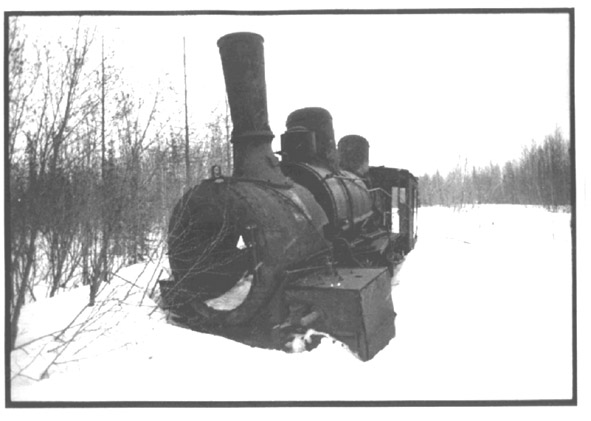|
|
|
||||
| About me
|
|||||
| Guest book
|
Historical essay For those who have forgotten but do not want to forget... |
||||
ESSAY: |
|
||||
Мертвая дорога часть 1
Dead Road part 1 (English) Dead Road part 2 (English) Dead Road part 3 (English)
Человека уже давно клонировали...
А толку что?
|
DEAD ROAD - MUSEUM OF COMUNISM UNDER THE OPEN
The documents contained data about 473 prisoners. The card-index included 305 personal cards, each showing the family name, Christian name and patronymic of the prisoner, the article of law by which he was convicted and his term of imprisonment. Some cards indicated the prisoner's nationality, education, profession and home address. The statistical conclusion made from studying and analyzing these card-index data confirmed and supplemented the oral evidence offered by the participants of the construction. Analysis of the card index data reveals that on the average half the number of prisoners were the so-called enemies of the people, i. e. persons sentenced to terms of imprisonment from 10 to 25 years, by shamefully notorious article No. 58 of the then criminal code punishing citizens for political crimes against the Stalinist regime. This article introduced several gradations of crimes from points 1-a and 3 (high treason in war time and collaboration with the enemy) to point 13 (belonging to the exploiter classes). It goes without saying that the majority of those «enemies of the people» had never committed any actions falling under this monstrous legislation. Some of them were involuntary victims of the Stalinist political campaigns and purges which shook the country. As for the others, the Communist state recruited them, , by using this unlawful method, as gratuitous work force to toil free of charge at its «great constructions». The overwhelming majority of prisoners convicted by article No. 58 came from the USSR Western regions directly hit by World War 2. Very often the only guilt of those people was that before they got under the jurisdiction of the Communists, they had lived under other regimes which were not as ugly as they were depicted by Soviet propaganda. Among the Dead Road prisoners there were a great number of Soviet soldiers who had been taken prisoner by the Germans. Working in the Dead Road camps were German and Japanese POWs, so-called «historical counter-revolutionaries»—White-Guard emigrants the NKVD captured during the war in Europ, as well as members of underground organizations and guerrillas who had fought against the Nazis (they aroused particular suspicion and hostility on the part of Stalin and the prison authorities). Imprisoned there were also functionaries of different foreign parties and organizations, participants of the Polish Resistance who had fought against Hitler in the ranks of the Armia Krajowa, persons interned in Germany, and just Soviet citizens who had lived for some time on territories occupied by Hitler. A special group of «enemies of the people» consisted of persons who had really participated in the armed struggle against the USSR for the independence of their territories—mostly inhabitants of Western Ukraine. Ukrainians constituted probably the largest national group of the Dead Road slaves. Of special interest is the social structure of the Railway camps. Unlike 1937-38, among the prisoners convicted under article 58, there were almost no representatives of the anaemic party-state nomenclatura. To accomplish the grandiose Stalinist construction ideas sloggers were wanted. That's why the majority of «political» convicts serving their sentences on the Dead Road were workers and peasants, lorry-drivers, tractor-drivers, carpenters, joiners, electricians, etc. Another source that provided the camps with lots of well-trained workers was the decree issued June 4, 1947, «On the Struggle against Theft of Socialist Property». By this decree a USSR citizen could be sentenced (and was often sentenced!) to an excessively prolonged 25 years' camp imprisonment for a trifling misdemeanour, such as a few kilograms of grain taken home from a collective farm storehouse, or a reel of thread stolen from a factory. The number of convicts condemned by this decree made up 15 per cent of all prisoners. Though the proportion of intellectuals in the Dead Road camps was not large, almost all intellectual professions were represented there. In the barracks could be found engineers, teachers, doctors, writers, painters, , composers, architects, lawyers, scientists, professional servicemen. For several years a real mobile theater functioned at the Railway, whose company consisted of professional actors condemned by article No. 58. Imprisoned in the camps were, for instance, the well-known theatre producer Leonid Obolensky, conductor N. Chernyatinsky, pianist V. Topilin, the famous atheletes brothers Starostin By far not all the intellectuals and professionals were given work to suit their specialities. Most of them served their term, doing, while they were strong enough, common work—with wheel barrow and shovel. The remaining prisoners, a little less than 35 per cent, were persons convicted under criminal articles. That «swell mob» was a real disaster for the political prisoners whom they taunted, terrorized, robbed and even killed. The criminals, as a rule, unaccustomede to work, despised labour interests and labour relations. By fair means or foul they did their utmost to shirk work, appropriate the results of other people’s toil, and force out the political prisoners to harder working places. The criminal elite—the so-called «thieves by law»—did not participate in the common work. The camp authorities were rather indulgent to these phenomena, considering as they did, that the terror to which the criminals subjected the political prisoners, was an important measure to maintain camp and working discipline. The GULAG Authorities of the Dead Road diversified the methods of terror with rewards for labour enthusiasm. If a prisoner fulfilled an especially urgent task he was renumerated with some additional foodstuffs, makhorka (inferior tobacco), or even alcohol. So-called «socialist emulation» was introduced among the prisoners. Teams of slaves assumed «socialist obligations»: the results were summed up by the Authorities who rewarded the half-starved, ragged winners, then and there, inside the barbed wire fence, with an additional food ration. According to the propaganda assurances of the USSR Communist leadership, socialist emulation was, under Socialism, one of the main incentives to work. The effectiveness of this incentive seems rather doubtful. Both at liberty and behind barbed wires emulation amounted to upward distortion of results and juggling with facts. But the Communist Party stubbornly compelled the whole country to “compete” in the” socialist way. “ Likewise the camp authorities were obliged to “involve” in socialist emulation their wards who were deprived of every right. But the most surprising thing was that in their attempts to make the prisoners work efficiently, the GULAG work effectively the GULAG authorities who usually did their utmost to prevent the prisoners’ release ahead of time, and even used the least opportunity to prolong their term, reverted to the long—forgotten pre-war system of credit marks by which, provided a prisoner overfulfilled his day task while observing the regime rules, one day of his (or her) camp term was counted for two or even three days. This innovation really aroused the prisoners’ enthusiasm! Quite unprecedentedly, in 1947, throughout the GULAG camp network a voluntary recruitment of prisoners was announced to work at the Dead Road construction. Thousands of long-term prisoners from all parts of the country moved to the severe North in search of the desired forthcoming freedom. They were naturally transported there under escort through transit prisons, accompanied by shouts of the guards and the barking of watchogs. Because the GULAG regime envisaged for prisoners, even builders-volunteers, no other way of transportation. Simultaneously, driven to the Dead Road were fresh forces of Soviet citizens, naturally without their consent, who had just been sentenced by Stalinist courts to long terms of GULAG slavery. In early 1948, the chekist initiated volunteer game came to an end: the GULAG authorities issued an order to rid the camps of the central regions of the country of all political prisoners, and send them to build the Dead Road. As for the system of credit marks, they were alternately now cancelled, now introduced again. The MIA guard officers and civilian builders enjoyed considerable privileges in comparison with the common Soviet citizens. To attract them to the construction, the Stalinist state offered them long holidays and furloughs, the highest Northern coefficient (that is, double payment), increasing it by 10 per cent each half year. Nevertheless they mostly led a dog’s life on the Dead Road. With or without their families they huddled for many years in dwellings essentially of the same type as the prisoners’ barracks, in an area ‘in which everyday amenities were out of the question. Though the Socialist state firmly kept its promises to this category of workers, their living standards could be considered high only in comparison with the monstrous poverty to which the Stalin regime doomed the overwhelming majority of its citizens. It should be noted that most civilian builders didn’t get to the Dead Road of their own free will. They were recruited from among the so—called “special migrants”exiled to Siberia: class alien persons, persons of undesirable origin (for example, Germans), former convicts allowed to live at liberty, and other deportees who remained in those out-of-the-way places, realizing that return to their native parts with their documents would draw MIA attention and would end in a new arrest and a new camp term. By far not all prisoners—Dead Road builders managed to survive even till such partial liberation. True, the situation at the Dead Road consruction was better than that at the other Stalinist constructions. Thus, A. Antonov-Ovseyenko, who was a camp prisoner of the neighbouring GULZHDS Kotlas-Vorkuta Railway line, testifies that in those Stalinist camps of the late 1930s—mid 1940s (like in the Hitlerite camps) the prisoner could endure the common work on the average not more than for three months running. Those of the greatest vitality got into the infirmary to return after some time to the column. The second failure at work, as a rule, ended in funeral, if one may so call the procedure of throwing the dead body into a pit without a coffin, but with a label with his record number tied to one of his legs, d—the camp passport kept by the authorities was following the prisoner in his wanderings around the GULAG). When there were two hundred corpses in the pit, the grave-diggers filled it with lumps of frozen soil. According to Shereshevsky’s testimony, in the GULZHDS camps of the Salekhard-Igarka Railway line the mortality rate was lower. The “funeral”” procedure though of a like nature, was less depersonalized; the prisoners were sometimes buried even individually, and the label contained not only the record number of the dead, but also his family name, age, article of conviction and prison term. On his grave, whether on the camp cemetery or beside the road, a peg was put with a board on it. The board showed a conventional code of letters and figures, like a car number. A register of correspondence between numbers and family names of the dead was kept for accounts in the safe of the Special Personnel Department of the camp. These and other account data were passed on to the authorities by selective communication in a primitively ciphered form. There are indications that in the late 1940s the deaththrate at the Dead Road was even lower than the average death-rate throughout the GULAG camps. The Railway camps were not severe-regimed, they did not aim at annihilating the prisoners. There were only several penalty columns there. The builders of the Dead Road received a meager ration, but they were not specially starved. However, in spite of the essential indulgence of the Dead Road camp regime by Stalinist standards, many thousands prisoner-builders never returned from those camps, perishing from diseases, exhaustive overwork, hard Polar life conditions, the tyranny of the criminals and the camp administration. Driven to despair by the camp conditions, some individual prisoners ventured to escape which was a desperate step. In fact, such a decision bordered on insanity. Where could one escape if surrounding the camp were enormous spaces of the country turned by Stalin into a similar labor camp, packed with MVD informers, though not so strict a regime? Where was there to run; when for hundreds of kilometers around there were vast spaces of the Siberian North hostile to life. Only a narrow stripe of Railway stretched across the Tundra. Psychologically, with all his being man was holding on to this thread connecting him with life and giving him hope for a brighter future. The camp life conditions must certainly have been unbearably hard to make the prisoner venture to escape, dooming himself to certain death. No doubt, almost all the fugitives were caught. There were cases when they themselves returned, preferring severe punishment to starvation. In terms of democracy and human rights, this kind of treatment of its subjects by the state looks like senseless mockery intended to harm them for no reason whatever. Still, analyzing the facts in the context of Soviet history, one begins to comprehend that at that last Stalinist “great construction” the Council of Ministers and the GULAG authorities, spared no equipment or investments, actually trying to effectively organize the builders’ work. Inspired by the forcible ideology of Bolshevism, they knew no better means to settle the tasks of the national economy than to drive the workers into squares of barbed wire, depriving them of will and rights, economizing on their wages, food and clothes. It might seem that the unlimited quantity of gratuitous labor, absence of manpower fluctuation, 9 hours’ working day (i. e. longer than at liberty), work without days off, absolute discipline and insignificant expenses to keep the workers under guard—all this was to demonstrate to the whole world the miracle of effectiveness of Communist production... But the miracle didn’t come to pass. Stalin’s death in 1953, marked the end of this senseless undertaking. As has already been mentioned, the construction was stopped by the decree of the Council of Ministers. By the same decree the other GULAG “great constructions” were discontinued as “not meeting the national economy requirements”: the Main Turkmen Canal, the Samotechny Volga-Ural Canal, The Volga-Baltic Waterway, the hydroelectric power station on the lower Don, the Ust-Don Port, the Komsomolsk-Pobedino Railway over twenty hydro-technical and transport constructions altogether. That and some other decisions taken by the Council of Ministers reflected the serious changes in the structure of the Soviet state organization. Thus the Council of Ministers’ decree of March 18, 1953 envisaged the transference of most GULAG camps to the authority of the USSR Ministry of Justice. The MVD USSR Construction chief administrative boards (Glavks) were placed under the authority of the corresponding civil ministries. On March 27, the USSR Supreme Soviet issued a decree on amnesty, to release over a million GULAG prisoners. Simultaneously, the passport and regime limitations were abolished in 340 Soviet cities. All these measures cut the ground from under the feet of the Mighty Empire of the Stalinist camps. Meanwhile the GULAG problem remained open and required solution. In 1956, N. Khrushtchev cautiously condemned Stalinism and half-opened the curtain hiding the scale of the camp system. The release began of political prisoners overlooked by by the amnesty. The Criminal Law was profoundly recast providing the citizens with better guarantees against the arbitrary rule of the courts. Nevertheless, finding himself behind barbed wire, the convict encountered camp conditions very similar to those of the former times. After N. Khrustchev was stripped of his power in 1964, the idea of the GULAG underwent substantial changes. True, the communist system was not going to give up the use of forced labor, or the practice of keeping convicts in inhuman conditions. But at the new stage of socialism, in connection with cutting down the financing of the great constructions, and the fear of international reaction, a trivial idea was developed: instead of attempting to make the slave labour super-effective, it was decided to turn the camp system at least into a self-repaying organization. For a long time the creative efforts of KGB and MVD specialists were directed to elaborating this principle. In recent years they used modern computer techniques to achieve this cherished aim. The use of computers to raise the efficiency of slave labour at last brought about the desired results. The two and a half million-strong army of prisoners began to work on a self-repaying scheme for the good of their Socialist Motherland. Still, the slave-owning essence of the Soviet penitentiary system remained intact even after six years of Gorbachev’s Perestroika. Soviet socialism continued stubbornly to pursue the Dead Road policy, punishing people with labour. Those who didn’t wish to work in slavery for a beggarly remuneration were even threatened with a punishment cell and starvation rations. The Soviet economy reports never mentioned the share of the output produced by slaves. Judging by many indications, it was not a small one. For instance, it is known that part of the contract on laying the Baikal-Amur Railway line undertaken in Brezhnev’s time, was given, as in former times, to GULAG. The only difference was that its slaves were presented by Soviet propaganda as Komsomol volunteers. It is highly probable that in their everyday life Soviet people constantly come across articles made by contemporary slaves, because the GULAG produced a lot of household objects: furniture, glass ware, bricks, cement, a great variety of hardware and building materials. This slavery firm, had out of modesty, no special trade-mark for its goods. 4. Summary To return to the Dead Road itself. Before finishing our narrative about its history, we would like to estimate the scope of damage inflicted on the USSR economy by the ignominious construction epopee of the Stalinist leadership. To make such an estimation is no easy task, but we’ll try at least to outline some ways of finding an answer to it. As has already been stated, the expenditure estimates of the MVD USSR experts who designed the Salekhard-Igarka Railway line amounted to a sum of more than 6 billion roubles calculated at state prices of those times. That money was to be spent on the construction during a term of about 4 years. In order to realize how great a sum it was for the Soviet Union, it is enouh to state that it equalled 12. 5 per cent of all capital investments in the railway construction in the 1946-1950 five-year plan amounting to 2, 5 per cent of all the capital investments in the USSR during that period. By 1953 the builders had been able to spend over a half of that money, which, as it turned out later, was simply thrown to the wind. This senseless expenditure is not to be looked upon as an expensive whim of a prosperous superpower. The money was withdrawn by the Stalinist leaders from the beggarly budget of the starving war ravaged country, and consequently irrevocably lost for the actually necessary programs of restoring the USSR national economy. Full calculation of the damage, should besides, include another very important component part: had the money spent on the Railway, been cleverly invested in production or transportation development it could have given the state an income of several hundred per cent. This potential income which was not received should be added to the calculated damage. Thus, the calculation shows that the consequences of this one “Great Construction” alone was to affect the USSR economy for dozens of years, and the total losses caused by it most probably exceeded 10 billion roubles. But even this figure doesn’t axhaust the damage inflicted on the country by the Stalinist construction adventure. The slaves of the GULAG, i. e. common Soviet citizens with all their working experience, with all their creative initiative, were lost for society for years, if not for ever. Had they lived a normal free life, they would have been of such benefit to the society as was utterly impossible when enslaved. How did the Stalinist designers of the “great constructions” take into account these considerations? Indeed, by what value could they estimate the incredible sufferings of the Dead Road builders, their senselessly exhaustive labour, their ruined health and lives, their wives’ widowhood, their children’s orphanhood? Without giving a thought to it, they equalled all these damages to naught. All that has been said here equally applies to all the other Stalinist construction epics. Each “great construction” undertaken by the Communist leaders, caused the USSR national economy quite definite and very telling damage which fact was concealed from the country’s population and the rest of the world by the party propaganda media, by the efforts of the OGPU-MGB-KGB secret police, and also by the price disproportion deliberately maintained in the economy. Of these gigantic GULAG constructions, about twenty have remained unfinished. If you add up the huge sums of money wasted by the Communists and never returned to the people, you will understand why one of the richest countries of the world couldn’t get out of hunger and poverty. A traveller finding himself today in the Dead Road region, of the Salekhard-Igarka Railway gets a surrealistic impression of the landscapes opening up before him. In the dense low forest which has grown along the Railway during the last 40 years, his glance is attracted by articles most unexpected for this uninhabited land, from table sewing machines to huge engines eaten by corrosion. Through the tree leaves he can see half-ruined camps encircled with barbed wire, dead settlements deserted by their dwellers, fantastic contours of the deserted town of Yermakovo. The embankment covered with bushes, with rotten crooked rails and ruined bridges stretches forward as far as the horizon. Moving down this Railway day after day, kilometer after kilometer you ever more clerly realize how great a destuctive force was contained in the senseless Bolshevik ideas—the ideas that intended to destroy the whole world to its foundation. July-December 1991, Moscow
|
||||
| |
|||||
 |
 |
||||
| Red shift of a phase? | Их паровоз с пути слетел... Photo by A. Vologodsky | ||||


